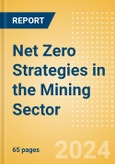- Nearly every mining company has a long term net zero goal
Scope 1 and 2, which are generated by business operations, make up around 40% of total emissions and main contributors include the use of heavy machinery, ore transportation, various on site processes, and the purchase of electricity. Mining companies are investing heavily in renewable energy, with many setting short term 100% renewable energy targets. Around 60% of emissions in the mining sector are value chain emissions, known as Scope 3. Downstream value chain emissions are generally much higher compared to the upstream side and most of these arise from the processing of sold products and transportation and distribution.
Shifting power sources is the main game in town
Increasing the share of renewable energy consumption is a primary way to achieve operational emissions reduction in the short term. This shift is facilitated through Power Purchase Agreements (PPAs) and, when grid power is unavailable where mining companies operate, directly through on site power plants. Instead, diesel displacement in favor of mining vehicles powered by electric batteries or fuel cells is a medium term emissions reduction strategy. In addition to this, supply chain collaboration is key to reducing value chain emissions. Companies need to work with downstream industries to jointly develop and implement emission reduction initiatives such as the optimization of transport methods and the use of cleaner sources of energy and energy efficient technologies. Many mining companies heavily reliant on steel making companies are switching away from blast furnaces or adopting carbon capture.
Key Highlights
Nearly every mining company has a long term net zero goal > Most mining companies have set 2050 as the target year for achieving net zero carbon emissions. In the interim (2025 2035), they will implement shorter-term emission reduction goals, typically aiming for around a 30% reduction by 2030.Scope 1 and 2, which are generated by business operations, make up around 40% of total emissions > Mining companies are investing heavily in renewable energy, with many setting short term 100% renewable energy targets. Around 60% of emissions in the mining sector are value chain emissions, known as Scope 3. Downstream value chain emissions are generally much higher compared to the upstream side and most of these arise from the processing of sold products and transportation and distribution.
Shifting power sources is the main game in town > Increasing the share of renewable energy consumption is a primary way to achieve operational emissions reduction in the short term. This shift is facilitated through Power Purchase Agreements (PPAs) and, when grid power is unavailable where mining companies operate, directly through on site power plants.
Supply chain collaboration is key to reducing value chain emissions > Companies need to work with downstream industries to jointly develop and implement emission reduction initiatives such as the optimization of transport methods and the use of cleaner sources of energy and energy efficient technologies.
Scope
The “Net Zero Strategies in the Mining Sector” thematic intelligence report gives you an in-depth insight into the net zero targets and performance of 20 power companies. The report elucidates the importance of a net zero strategy in the mining sector along with the progress made by the leading companies to achieve the emission target. These detailed analyses are critical in developing effective business plans to gain a competitive edge.Reasons to Buy
This report -- Discusses the impact of GHG emissions by mining companies and strategies adopted to mitigate emissions.
- Evaluates various scopes of emissions emanating from the mining industry
- Benchmarks leading companies based on their emissions reduction pathway and net zero commitments.
Table of Contents
- Executive Summary
- Why Mining Companies Need a Net Zero Strategy
- Emissions Targets and Performance
- Scope 1 and 2 Emissions Strategies
- Scope 3 Emissions Strategies
- Net Zero Strategies of Leading Companies
- Glossary
- Further Reading
- Thematic Research Methodology
- Contact the Publisher
Companies Mentioned (Partial List)
A selection of companies mentioned in this report includes, but is not limited to:
- Agnico Eagle Mines
- Anglo American
- Antofagasta
- Barrick Gold
- BHP
- Coal India
- First Quantum Minerals
- Freeport-McMoRan
- Fortescue Metals
- Glencore
- Harmony Gold Mining
- Newcrest Mining
- Newmont
- Norilsk Nickel
- Rio Tinto
- Saudi Arabian Mining (Ma'aden)
- Sibanye Stillwater
- South32
- Teck Resources
- Vale








